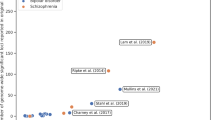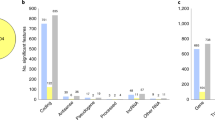Abstract
Genome-wide association studies (GWAS) have identified several common variants associated with bipolar disorder (BD), but the biological meaning of these findings remains unclear. Integrative genomics—the integration of GWAS signals with gene expression data—may illuminate genes and gene networks that have key roles in the pathogenesis of BD. We applied weighted gene co-expression network analysis (WGCNA), which exploits patterns of co-expression among genes, to brain transcriptome data obtained by sequencing of poly-A RNA derived from postmortem dorsolateral prefrontal cortex from people with BD, along with age- and sex-matched controls. WGCNA identified 33 gene modules. Many of the modules corresponded closely to those previously reported in human cortex. Three modules were associated with BD, enriched for genes differentially expressed in BD, and also enriched for signals in prior GWAS of BD. Functional analysis of genes within these modules revealed significant enrichment of several functionally related sets of genes, especially those involved in the postsynaptic density (PSD). These results provide convergent support for the hypothesis that dysregulation of genes involved in the PSD is a key factor in the pathogenesis of BD. If replicated in larger samples, these findings could point toward new therapeutic targets for BD.
Similar content being viewed by others
Log in or create a free account to read this content
Gain free access to this article, as well as selected content from this journal and more on nature.com
or
References
Akula N, Barb J, Jiang X, Wendland JR, Choi KH, Sen SK et al (2014). RNA-sequencing of the brain transcriptome implicates dysregulation of neuroplasticity, circadian rhythms and GTPase binding in bipolar disorder. Mol Psychiatry 19: 1179–1185.
Anders S, Huber W (2010). Differential expression analysis for sequence count data. Genome Biol 11: R106.
Andersson R, Gebhard C, Miguel-Escalada I, Hoof I, Bornholdt J, Boyd M et al (2014). An atlas of active enhancers across human cell types and tissues. Nature 507: 455–461.
Barry G (2014). Integrating the roles of long and small non-coding RNA in brain function and disease. Mol Psychiatry 19: 410–416.
Beneyto M, Meador-Woodruff JH (2008). Lamina-specific abnormalities of NMDA receptor-associated postsynaptic protein transcripts in the prefrontal cortex in schizophrenia and bipolar disorder. Neuropsychopharmacology 33: 2175–2186.
Bernard D, Prasanth KV, Tripathi V, Colasse S, Nakamura T, Xuan Z et al (2010). A long nuclear-retained non-coding RNA regulates synaptogenesis by modulating gene expression. EMBO J 29: 3082–3093.
Bild AH, Chang JT, Johnson WE, Piccolo SR (2014). A field guide to genomics research. PLoS Biol 12: e1001744.
Chen C, Cheng L, Grennan K, Pibiri F, Zhang C, Badner JA et al (2013a). Two gene co-expression modules differentiate psychotics and controls. Mol Psychiatry 18: 1308–1314.
Chen DT, Jiang X, Akula N, Shugart YY, Wendland JR, Steele CJ et al (2013b). Genome-wide association study meta-analysis of European and Asian-ancestry samples identifies three novel loci associated with bipolar disorder. Mol Psychiatry 18: 195–205.
Choi KH, Higgs BW, Wendland JR, Song J, McMahon FJ, Webster MJ (2011). Gene expression and genetic variation data implicate PCLO in bipolar disorder. Biol Psychiatry 69: 353–359.
Clarke C, Madden SF, Doolan P, Aherne ST, Joyce H, O'Driscoll L et al (2013). Correlating transcriptional networks to breast cancer survival: a large-scale coexpression analysis. Carcinogenesis 34: 2300–2308.
Dong J, Horvath S (2007). Understanding network concepts in modules. BMC Syst Biol 1: 24.
el-Mallakh RS, Wyatt RJ (1995). The Na,K-ATPase hypothesis for bipolar illness. Biol Psychiatry. 37: 235–244.
Feng W, Zhang M (2009). Organization and dynamics of PDZ-domain-related supramodules in the postsynaptic density. Nat Rev Neurosci 10: 87–99.
Fromer M, Pocklington AJ, Kavanagh DH, Williams HJ, Dwyer S, Gormley P et al (2014). De novo mutations in schizophrenia implicate synaptic networks. Nature 506: 179–184.
Fuller TF, Ghazalpour A, Aten JE, Drake TA, Lusis AJ, Horvath S (2007). Weighted gene coexpression network analysis strategies applied to mouse weight. Mamm Genome 18: 463–472.
Gaiteri C, Ding Y, French B, Tseng GC, Sibille E (2014). Beyond modules and hubs: the potential of gene coexpression networks for investigating molecular mechanisms of complex brain disorders. Genes Brain Behav 13: 13–24.
Gumieiro EH, Abrahao M, Jahn RS, Segretto H, Alves MT, Nannmark U et al (2010). Platelet-rich plasma in bone repair of irradiated tibiae of Wistar rats. Acta Cir Bras 25: 257–263.
He Z, Bammann H, Han D, Xie G, Khaitovich P (2014). Conserved expression of lincRNA during human and macaque prefrontal cortex development and maturation. RNA 20: 1103–1111.
Hong S, Chen X, Jin L, Xiong M (2013). Canonical correlation analysis for RNA-seq co-expression networks. Nucleic Acids Res 41: e95.
Huang, da W, Sherman BT, Lempicki RA (2009a). Bioinformatics enrichment tools: paths toward the comprehensive functional analysis of large gene lists. Nucleic Acids Res 37: 1–13.
Huang, da W, Sherman BT, Lempicki RA (2009b). Systematic and integrative analysis of large gene lists using DAVID bioinformatics resources. Nat Protoc 4: 44–57.
Iancu OD, Colville A, Darakjian P, Hitzemann R (2014). Coexpression and cosplicing network approaches for the study of mammalian brain transcriptomes. Int Rev Neurobiol 116: 73–93.
Iancu OD, Kawane S, Bottomly D, Searles R, Hitzemann R, McWeeney S (2012). Utilizing RNA-Seq data for de novo coexpression network inference. Bioinformatics 28: 1592–1597.
Kristiansen LV, Meador-Woodruff JH (2005). Abnormal striatal expression of transcripts encoding NMDA interacting PSD proteins in schizophrenia, bipolar disorder and major depression. Schizophr Res 78: 87–93.
Langfelder P, Castellani LW, Zhou Z, Paul E, Davis R, Schadt EE et al (2012). A systems genetic analysis of high density lipoprotein metabolism and network preservation across mouse models. Biochim Biophys Acta 1821: 435–447.
Langfelder P, Horvath S (2007). Eigengene networks for studying the relationships between co-expression modules. BMC Syst Biol 1: 54.
Langfelder P, Horvath S (2008). WGCNA: an R package for weighted correlation network analysis. BMC Bioinformatics 9: 559.
Langfelder P, Luo R, Oldham MC, Horvath S (2011). Is my network module preserved and reproducible? PLoS Comput Biol 7: e1001057.
Li B, Tsoi LC, Swindell WR, Gudjonsson JE, Tejasvi T, Johnston A et al (2014). Transcriptome analysis of psoriasis in a large case-control sample: RNA-seq provides insights into disease mechanisms. J Invest Dermatol 134: 1828–1838.
Malki K, Pain O, Du Rietz E, Tosto MG, Paya-Cano J, Sandnabba KN et al (2014). Genes and gene networks implicated in aggression related behaviour. Neurogenetics 15: 255–266.
Maurano MT, Humbert R, Rynes E, Thurman RE, Haugen E, Wang H et al (2012). Systematic localization of common disease-associated variation in regulatory DNA. Science 337: 1190–1195.
McGettigan PA (2013). Transcriptomics in the RNA-seq era. Curr Opin Chem Biol 17: 4–11.
Muhleisen TW, Leber M, Schulze TG, Strohmaier J, Degenhardt F, Treutlein J et al (2014). Genome-wide association study reveals two new risk loci for bipolar disorder. Nat Commun 5: 3339.
Network and Pathway Analysis Subgroup of Psychiatric Genomics Consortium (2015). Psychiatric genome-wide association study analyses implicate neuronal, immune and histone pathways. Nat Neurosci 18: 199–209.
Oldham MC, Konopka G, Iwamoto K, Langfelder P, Kato T, Horvath S et al (2008). Functional organization of the transcriptome in human brain. Nat Neurosci 11: 1271–1282.
Pennington K, Beasley CL, Dicker P, Fagan A, English J, Pariante CM et al (2008). Prominent synaptic and metabolic abnormalities revealed by proteomic analysis of the dorsolateral prefrontal cortex in schizophrenia and bipolar disorder. Mol Psychiatry 13: 1102–1117.
Poultney CS, Samocha K, Kou Y, Liu L, Walker S, Singh T et al (2014). Synaptic, transcriptional and chromatin genes disrupted in autism. Nature 515: 209–215.
Psychiatric GWAS Consortium Bipolar Disorder Working Group (2011). Large-scale genome-wide association analysis of bipolar disorder identifies a new susceptibility locus near ODZ4. Nat Genet 43: 977–983.
Schadt EE (2006). Novel integrative genomics strategies to identify genes for complex traits. Anim Genet 37 (Suppl 1): 18–23.
Schizophrenia Working Group of the Psychiatric Genomics Consortium (2014). Biological insights from 108 schizophrenia-associated genetic loci. Nature 511: 421–427.
Segre AV, Groop L, Mootha VK, Daly MJ, Altshuler D (2010). Common inherited variation in mitochondrial genes is not enriched for associations with type 2 diabetes or related glycemic traits. PLoS Genet 6: pii: e1001058.
Torkamani A, Dean B, Schork NJ, Thomas EA (2010). Coexpression network analysis of neural tissue reveals perturbations in developmental processes in schizophrenia. Genome Res 20: 403–412.
Trapnell C, Pachter L, Salzberg SL (2009). TopHat: discovering splice junctions with RNA-Seq. Bioinformatics 25: 1105–1111.
Voineagu I, Wang X, Johnston P, Lowe JK, Tian Y, Horvath S et al (2011). Transcriptomic analysis of autistic brain reveals convergent molecular pathology. Nature 474: 380–384.
Walsh CA, Morrow EM, Rubenstein JL (2008). Autism and brain development. Cell 135: 396–400.
Zhang Y, Chen K, Sloan SA, Bennett ML, Scholze AR, O'Keeffe S et al (2014). An RNA-sequencing transcriptome and splicing database of glia, neurons, and vascular cells of the cerebral cortex. J Neurosci 34: 11929–11947.
Acknowledgements
We thank Drs Michael B Knable, E Fuller Torrey, Maree J Webster, Serge Weis, and Robert H Yolken at The Stanley Medical Research Institute for sharing brain tissue. We also thank Drs Barbara K Lipska and Joel E Kleinman at NIMH-IRP for providing us RNA from three control brains. Data analysis was performed on the Biowulf high-performance computing platform at the NIH. This study was funded by the Intramural Research Program of the NIMH (ZIAMH002810).
Author information
Authors and Affiliations
Corresponding author
Additional information
Supplementary Information accompanies the paper on the Neuropsychopharmacology website
Supplementary information
Rights and permissions
About this article
Cite this article
Akula, N., Wendland, J., Choi, K. et al. An Integrative Genomic Study Implicates the Postsynaptic Density in the Pathogenesis of Bipolar Disorder. Neuropsychopharmacol 41, 886–895 (2016). https://doi.org/10.1038/npp.2015.218
Received:
Revised:
Accepted:
Published:
Issue date:
DOI: https://doi.org/10.1038/npp.2015.218
This article is cited by
-
Integrated genomics analysis highlights important SNPs and genes implicated in moderate-to-severe asthma based on GWAS and eQTL datasets
BMC Pulmonary Medicine (2020)
-
Transcriptomic profiling of the human brain reveals that altered synaptic gene expression is associated with chronological aging
Scientific Reports (2017)
-
Proteomic analysis of the postsynaptic density implicates synaptic function and energy pathways in bipolar disorder
Translational Psychiatry (2016)
-
Consistently altered expression of gene sets in postmortem brains of individuals with major psychiatric disorders
Translational Psychiatry (2016)



